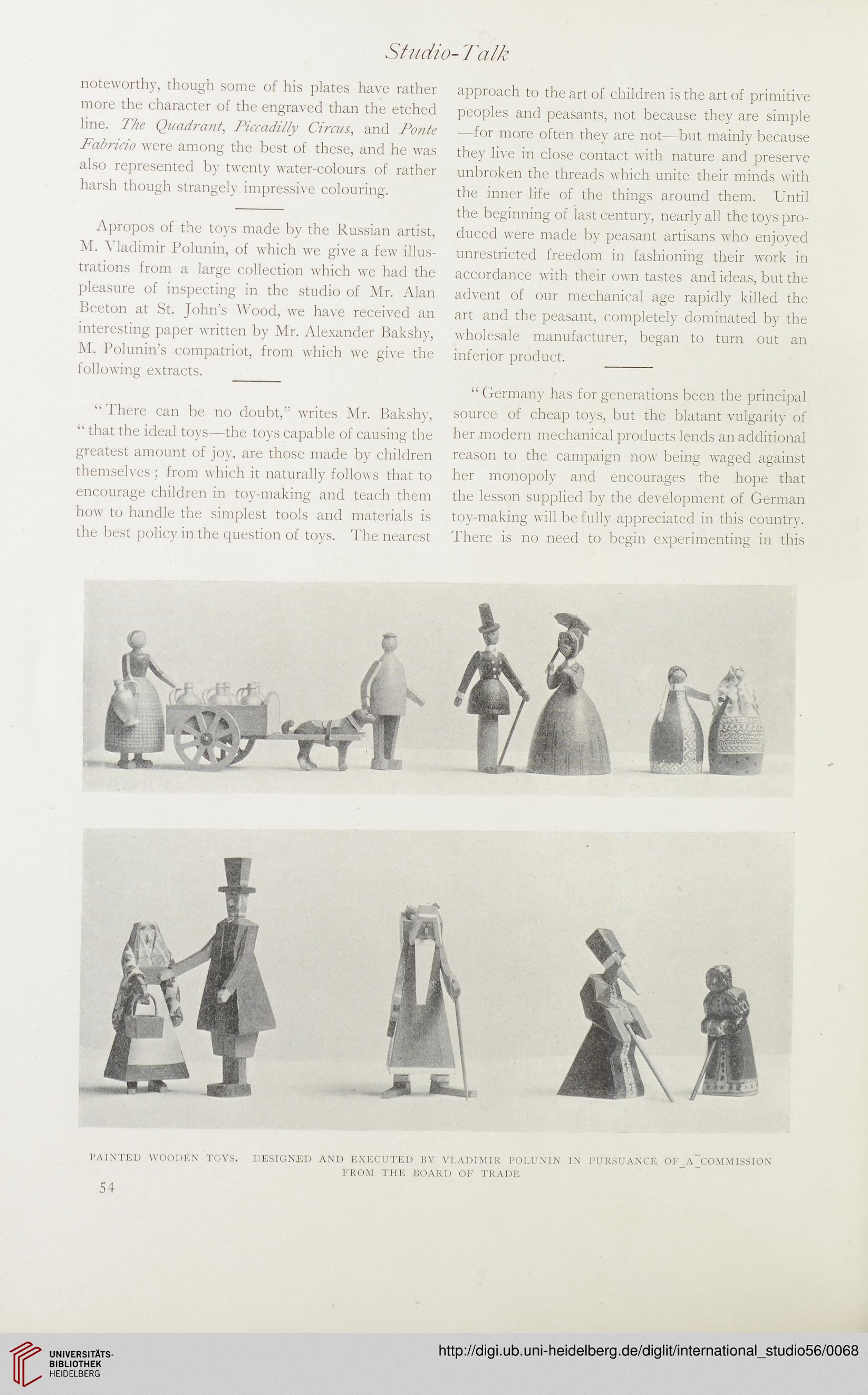Studio-Talk
noteworthy, though some of his plates have rather
more the character of the engraved than the etched
line. The Quadrant, Piccadilly Circus, and Ponte
Fabricio were among the best of these, and he was
also represented by twenty water-colours of rather
harsh though strangely impressive colouring.
Apropos of the toys made by the Russian artist,
M. Vladimir Polunin, of which we give a few illus-
trations from a large collection which we had the
pleasure of inspecting in the studio of Mr. Alan
Beeton at St. John’s Wood, we have received an
interesting paper written by Mr. Alexander Bakshy,
M. Polunin’s compatriot, from which we give the
following extracts.
“ There can be no doubt,” writes Mr. Bakshy,
“ that the ideal toys—the toys capable of causing the
greatest amount of joy, are those made by children
themselves; from which it naturally follows that to
encourage children in toy-making and teach them
how to handle the simplest tools and materials is
the best policy in the question of toys. The nearest
approach to the art of children is the art of primitive
peoples and peasants, not because they are simple
—for more often they are not—but mainly because
they live in close contact with nature and preserve
unbroken the threads which unite their minds with
the inner life of the things around them. Until
the beginning of last century, nearly all the toys pro-
duced were made by peasant artisans who enjoyed
unrestricted freedom in fashioning their work in
accordance with their own tastes and ideas, but the
advent of our mechanical age rapidly killed the
art and the peasant, completely dominated by the
wholesale manufacturer, began to turn out an
inferior product. _
“ Germany has for generations been the principal
source of cheap toys, but the blatant vulgarity of
her modern mechanical products lends an additional
reason to the campaign now being waged against
her monopoly and encourages the hope that
the lesson supplied by the development of German
toy-making will be fully appreciated in this country.
There is no need to begin experimenting in this
PAINTED WOODEN TOYS. DESIGNED AND EXECUTED BY VLADIMIR POLUNIN IN PURSUANCE OF^A COMMISSION'
FROM THE BOARD OF TRADE
54
noteworthy, though some of his plates have rather
more the character of the engraved than the etched
line. The Quadrant, Piccadilly Circus, and Ponte
Fabricio were among the best of these, and he was
also represented by twenty water-colours of rather
harsh though strangely impressive colouring.
Apropos of the toys made by the Russian artist,
M. Vladimir Polunin, of which we give a few illus-
trations from a large collection which we had the
pleasure of inspecting in the studio of Mr. Alan
Beeton at St. John’s Wood, we have received an
interesting paper written by Mr. Alexander Bakshy,
M. Polunin’s compatriot, from which we give the
following extracts.
“ There can be no doubt,” writes Mr. Bakshy,
“ that the ideal toys—the toys capable of causing the
greatest amount of joy, are those made by children
themselves; from which it naturally follows that to
encourage children in toy-making and teach them
how to handle the simplest tools and materials is
the best policy in the question of toys. The nearest
approach to the art of children is the art of primitive
peoples and peasants, not because they are simple
—for more often they are not—but mainly because
they live in close contact with nature and preserve
unbroken the threads which unite their minds with
the inner life of the things around them. Until
the beginning of last century, nearly all the toys pro-
duced were made by peasant artisans who enjoyed
unrestricted freedom in fashioning their work in
accordance with their own tastes and ideas, but the
advent of our mechanical age rapidly killed the
art and the peasant, completely dominated by the
wholesale manufacturer, began to turn out an
inferior product. _
“ Germany has for generations been the principal
source of cheap toys, but the blatant vulgarity of
her modern mechanical products lends an additional
reason to the campaign now being waged against
her monopoly and encourages the hope that
the lesson supplied by the development of German
toy-making will be fully appreciated in this country.
There is no need to begin experimenting in this
PAINTED WOODEN TOYS. DESIGNED AND EXECUTED BY VLADIMIR POLUNIN IN PURSUANCE OF^A COMMISSION'
FROM THE BOARD OF TRADE
54




